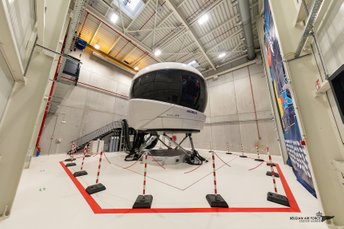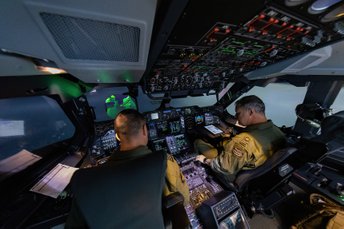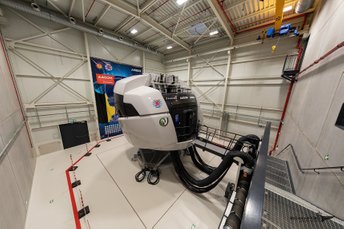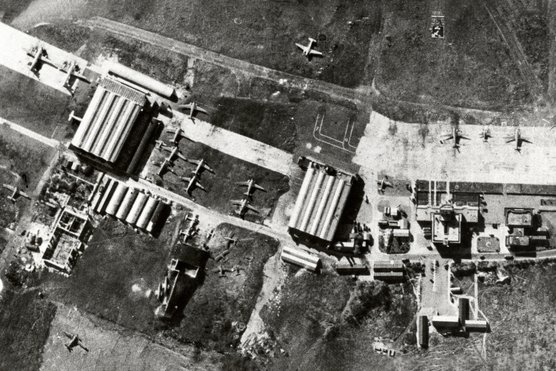
Evere aerodrome
At the start of World War II, Belgian pilots make their way towards the UK with the aim of enlisting in the Royal Air Force. Many of them will fight the German occupation forces as fighter or bomber pilots; some will be converted to pilot transport aircraft. By the end of the war, the 525th Squadron consisted entirely of Belgian crews, this unit will provide an air connection between London and Brussels after liberation.
During the year 1946, the 525th Sqn together with the 'Belgian Flight of the Metropolitan Communication Squadron' will settle at Evere airfield, both units will be merged and renamed the 169th Wing on April 1, 1947. This wing will consist of the 366th Squadron (equipped with 5 Dakotas) and the 367th Squadron (equipped with 9 Ansons, 6 Oxfords, 4 Dominies and 4 Proctors). A Transport Conversion Unit will also be created to convert pilots from combat units into transport pilots.
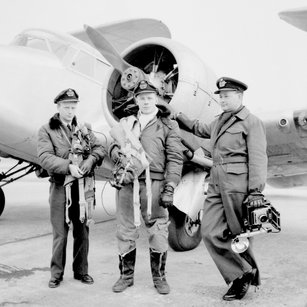
During 1947, connections with the colony are established, photographic missions begin on behalf of the Military Cartographic Institute, and on September 11 the first paradrop will be carried out over the airfield of Schaffen in Flemish Brabant. On February 1 1948, when the Belgian Air Force was created, the 169th Wing was renamed the 15th Transport and Liaison Wing (15 VVbW).
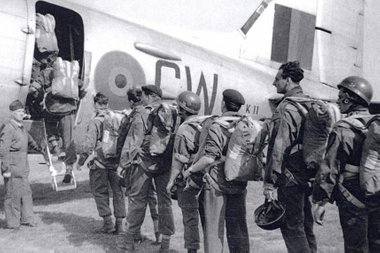
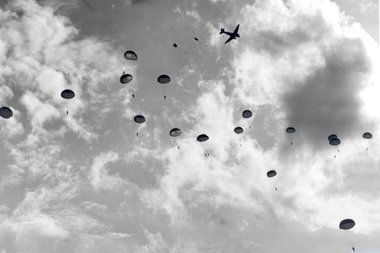
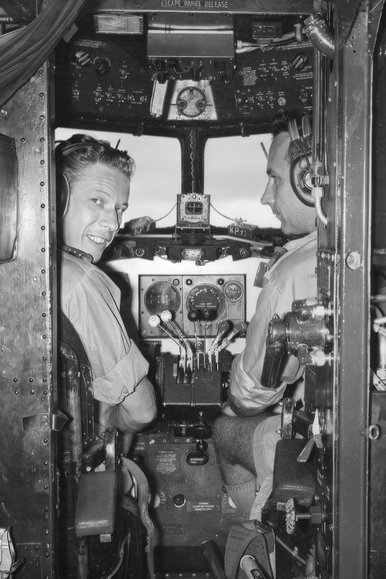
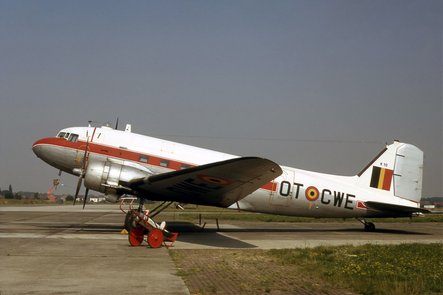
Het eerste staatsbezoek aan de kolonie door Prins Karel vertrok te Evere op 24 juni 1947 om 5 dagen later in Leopoldville aan te komen. De hele reis nam 104 vlieguren in beslag. Het was een DC-3 Dakota met tailnummer K-10 dat de zending uitvoerde.
Because of the Dakota's limited flying range and transport capacity, the Air Force bought two Douglas DC-4 'Skymasters' type aircraft in September 1950. With these aircraft, the journey to the colony took just one and a half days.
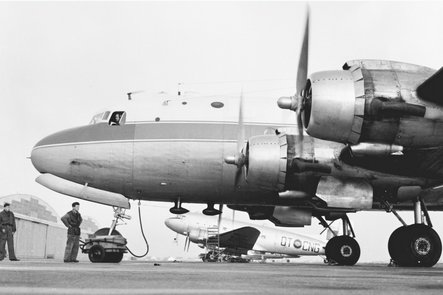
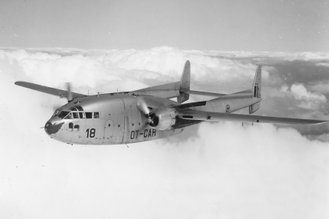
In September 1952, the first two Fairchild Packet C-119F 'Flying Boxcars' were delivered to Melsbroek base. The C-119, with its remarkable double tail, had a cargo bay that was large for that time and could carry up to three times more cargo than the DC-3. A total of 18 of these aircraft were delivered, followed by 28 examples of the C-119G type. The arrival of these aircraft marked the start of the tactical airlift capability for the Belgian Air Force.
The now outdated Ansons and Oxfords are replaced by twelve Percival P.66 Pembroke aircraft during the course of 1954. Besides their primary role as medium-range liaison aircraft, the Pembrokes are also used as conversion aircraft for the training of new transport pilots but also for calibration purposes and aerial photography commissioned by the CEEP (Centre d'Etude et d'Exploitation des Photographies).
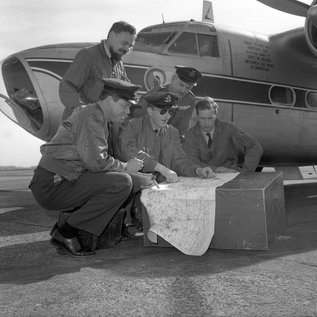
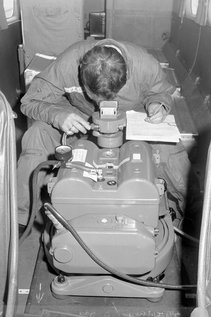
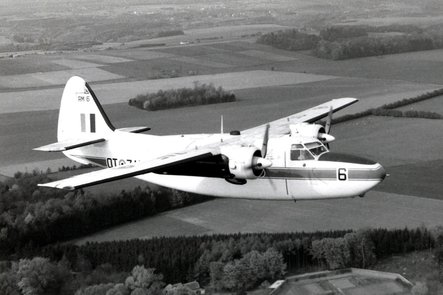
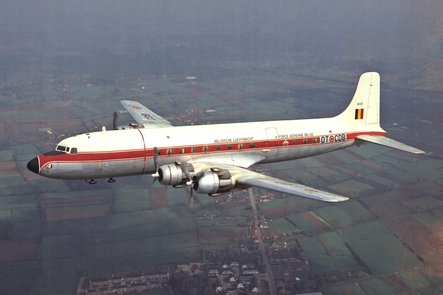
In 1958, two Douglas DC-6A Liftmasters were procured. This was in response to the rapid growth of pilot training at Kamina Air Base (Belgian Congo) and the need for transatlantic connections with the United States.
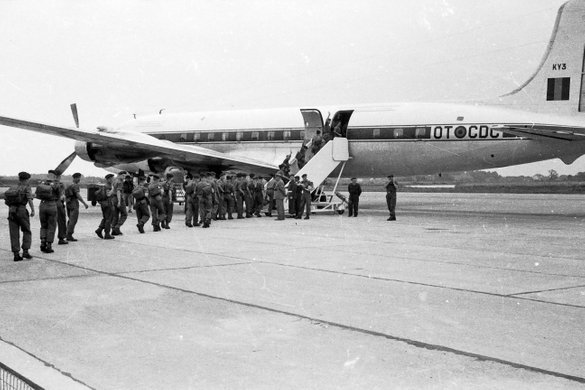
In 1960, the 15th Wing played an important role during operations in the Belgian Congo. This included dropping paratroopers and equipment in various rebel-occupied areas and eventually evacuating many Belgian and foreign nationals.
On December 17, 1962, as flight commander of DC-6 with registration KY-1, Captain Pilot Baccaert made Belgian aviation history by achieving the first connection with the United States. The destination, McGuire Air Force Base, was reached after stopovers at Prestwick (Scotland) and Goose Bay (Canada). The almost arctic temperatures of as low as -37° Celsius in Goose Bay made for a real challenge for both equipment and crew.
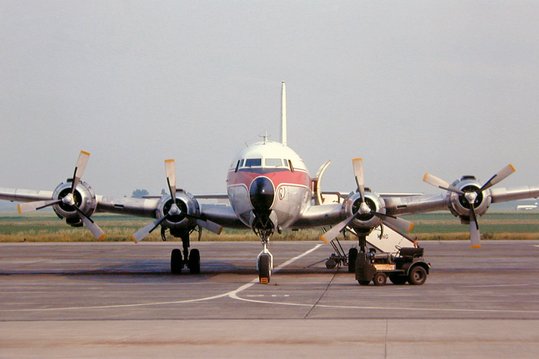
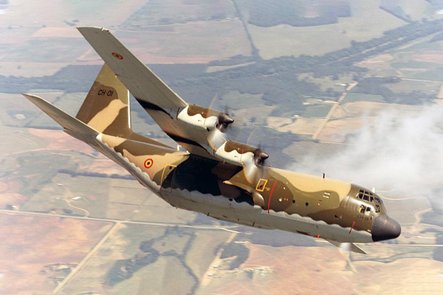
After Congo's independence and the subsequent troubled years, one of the main areas of operations for the 15th Wing disappeared. In 1972, the substantial fleet of C-119 Flying Boxcars, after a total of 157,500 flying hours, was stored at Koksijde and replaced by only twelve Lockheed C-130H Hercules transport aircraft. Over the next decades, the C-130Hs would become a tireless workhorse during numerous humanitarian missions and operations around the world.
On July 25, 1972, the first of twelve Belgian Hercules aircraft with registration CH-01 taxied onto the tarmac at Melsbroek. The aircraft immediately impressed with its large payload of 20 tonnes, which can be quickly loaded and unloaded thanks to a new loading system, and its long flight range. Its 'Short Take Off and Landing' (STOL) capabilities will also prove their worth several times over when one will have to land on the mostly remote and unpaved African airfields.
Following the renewal of the tactical transport fleet, the 21st Squadron's fleet of passenger aircraft also began renewal in 1973. Two Dassault Breguet Falcon 20E aircraft were purchased. These were mainly used as fast liaison aircraft for (V)VIP transport but also for organ transport and medical evacuations.
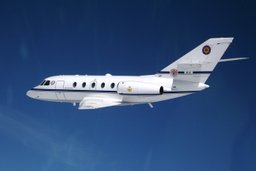
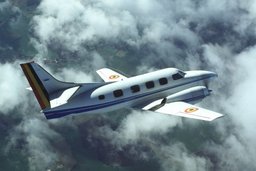
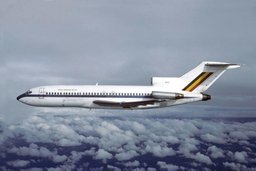
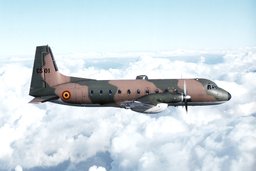
Six Swearingen Merlin IIIA turboprop aircraft are delivered on March 29, 1976. Two aircraft will be equipped for vertical aerial photography, mainly to serve the National Geographical Institute. During the same year, the Air Force purchases two Boeing B727 passenger aircraft from SABENA to replace the four DC-6A aircraft, and the first of three Hawker Siddeley HS748 is also commissioned. All these aircraft have the ability to be converted into cargo aircraft which significantly increases their deployability.
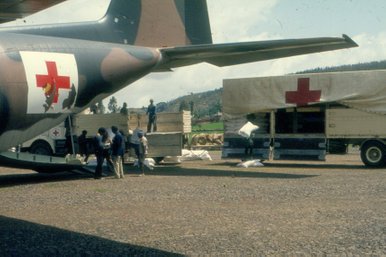
In the 1970s and 1980s, successive humanitarian crises and political unrest on the African continent resulted in the 15th Wing's tactical air supply capability being deployed by a range of NGOs, from The Red Cross to the EEC and the United Nations. Thus, in a very short time, our crews become experts in delivering food and evacuating people in need in places simply inaccessible by road transport.
Together with the Regiment Para-Commando, a technique was developed that allowed bulk airdropping of food without the use of parachutes in places where it was impossible to land an aircraft, this technique was called VLAGES. This method of delivery was first used in the Sahel region under great international interest. The very heavy work rate and scorching heat made this mission particularly tough for the crews and support personnel on the ground.
In May 1978, the Front National de Libération Concolais turned against the Europeans. There are reports of massacres, rape and looting. Because of this critical situation, the Belgian government decides to send 1,200 para-commandos to the Congo to bring some 2,300 countrymen to safety. In total, the 15th Wing deployed ten C-130H and two B727 aircraft, which was the entire available long-range fleet at that time. Three of these aircraft were already in Mali to participate in humanitarian operations there and were reoriented towards Kamina airbase in no time.
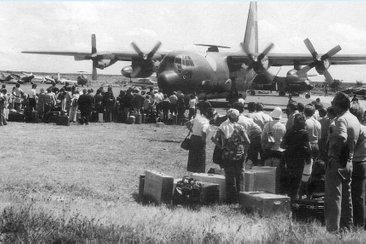
The decision was made to carry out an assault landing on Kolwezi airfield, this in two waves of four Hercules each. The sun in the back to blind any enemy gunners. This action is carried out a second time, bringing the entire detachment of 1,200 paratroopers to the scene in just two hours. The Belgians are evacuated to Kamina base from where they are flown aboard one of our B727s or by a B707 from SABENA towards Kinshasa or Europe. The operation is accomplished in just 56 hours, with a total of 148 flying hours by our C-130s.
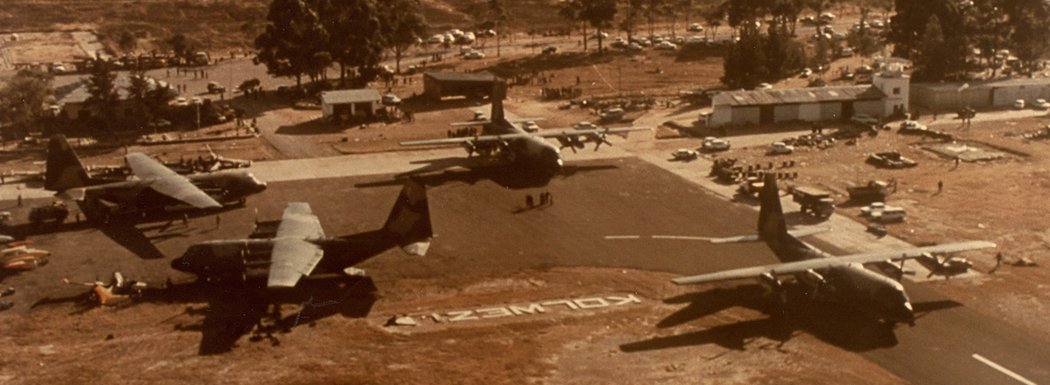
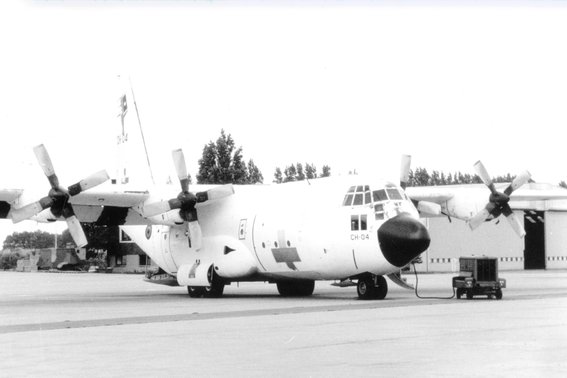
As part of Operation Lifeline (UN), a C-130H is sent to Karthoum to set up an airlift with South Sudan. Due to the civil war, there was a real chance that the aircraft would be taken under fire by government forces. It was therefore decided to paint all aircraft white with red crosses on them. On 22 April 1989, CH-04, nicknamed 'The white one from Melsbroek', took off, carrying as much as 2,173 tonnes of provisions and 300 passengers in three months.
In an attempt to overthrow President Habiyarimana's rule, armed rebels are causing great unrest in Rwanda. Because of shootings in the capital Kigali, the Belgian government advises compatriots on the scene to prepare for a possible evacuation. On 4 October, the government decides to deploy a contingent of 540 para-commandos to protect Belgian civilians under the name Operation Green Bean. Barely four hours after this decision, a first C-130H with 25 soldiers and equipment took off at Melsbroek, followed an hour later by the first B727 with 105 soldiers. During the night of 5-6 October, everyone is on the spot and, together with Rwandan troops and French Légionnaires, the town and airport are secured. This causes the peace to return and hostilities to cease; no evacuation ultimately occurs. Once again, the 15th Wing together with the Regiment Para-Commando show their ability to intervene very quickly in remote areas.
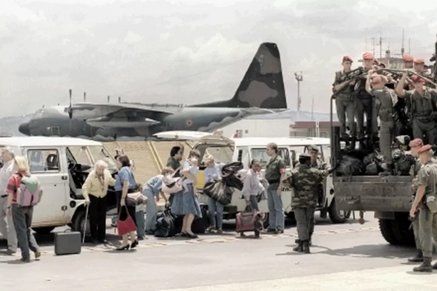
The incursion of Iraqi forces under Saddam Hussein's command into the Gulf state of Kuwait created a new international conflict. The airlift capability of the 15th Wing will be used not only to support our own forces in the region, but also for the benefit of other coalition forces.
- Logistical support to Belgian fighter aircraft and Dutch Patriot batteries in Diyarbakir (Turkey).
- Deployment of a Belgian medical detachment in Cyprus.
- Airlift for Egyptian refugees between Amman and Cairo.
- Logistical support to the Naval Forces operating in the Persian Gulf with 3 minesweepers, 1 frigate and a logistical support ship.
- Humanitarian assistance to Kurdish refugees in northern Iraq.
- Logistical support under the framework of the WEU for the benefit of British and French forces.
In 1991, eleven C-130s and two Boeing B727s took part in the humanitarian operation Blue Beam. At the time, the Zairean capital Kinshasa was facing heavy rioting and looting targeting the property of the white population. Aircraft were deployed from September to November to evacuate Belgian nationals at various locations in Zaire, among other things. More than 4,000 civilians were evacuated. The Belgian defence forces were reinforced by a Portuguese C-130, which was given a blue Sioux and the registration 'CH-14' for the occasion.
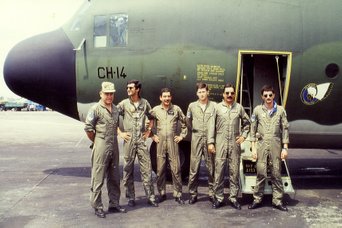
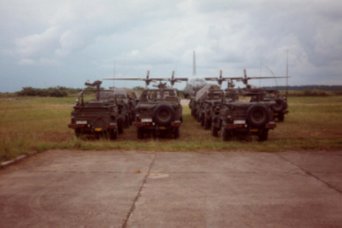
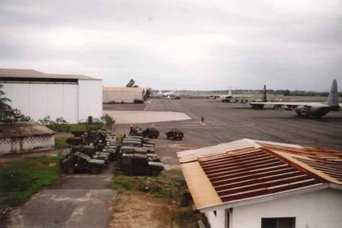
To meet the growing demand for VVIP flights, the Belgian government decided to purchase a second-hand Dassault Falcon 900B in March 1995. This aircraft has an intercontinental flying range and seats 12 passengers. It is mainly used by members of the government and the royal family.
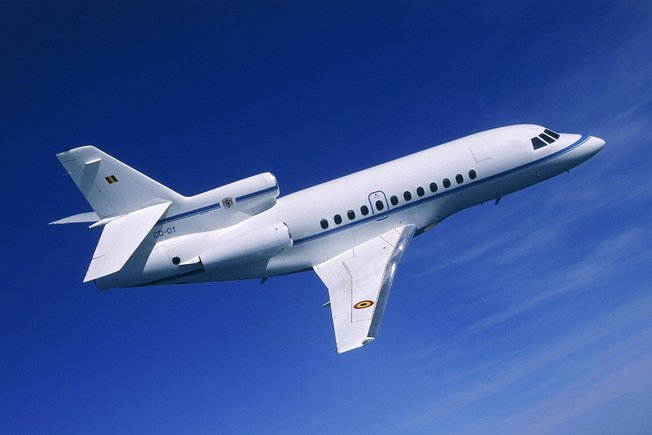
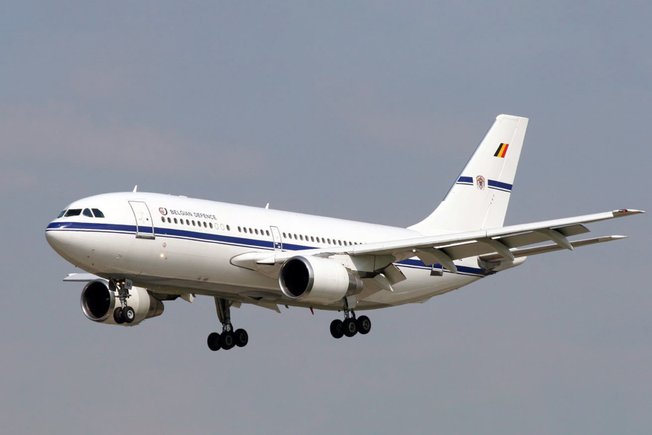
The ageing Boeing B727s are proving unable to cope with the rising demand for long-haul transport. The government decides to replace them but budgetary constraints do not allow for the purchase of new aircraft, so it will rely on two second-hand Airbus A310-222 aircraft that previously served Singapore Airlines. This purchase will significantly increase the strategic air transport capacity of Belgian defence.
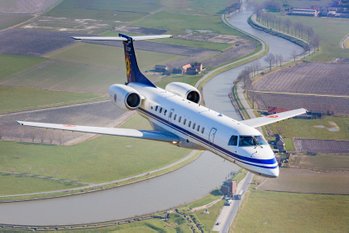
In 2001, two Embraer ERJ135 passenger aircraft will enter service along with two larger ERJ145. They will mainly be used for regional liaison flights within Europe, but also worldwide. The four jets can be configured to transport patients during medical evacuations and will also be used to transport high-level people.
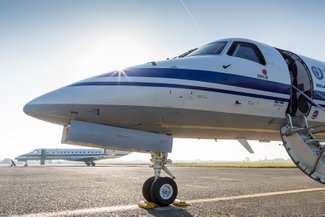
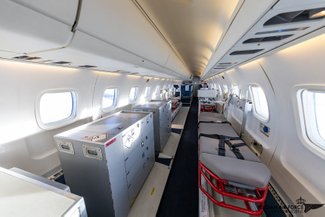
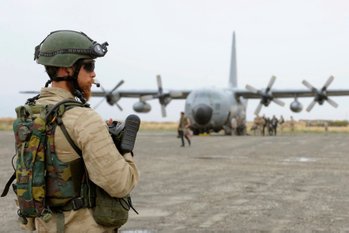
In September 2001, the attacks on the World Trade Center mark the beginning of the 'War on Terror' and the hunt for Osama Bin Laden. Belgium participates in the international coalition ISAF (International Security Assistance Force), set up to support President Karzai's regime and oust the Taliban. Successive F-16 detachments, the surveillance mission of Kabul International Airport, the training of Afghan troops and the many other Belgian missions ensure that our C-130s will be continuously present in the Afghan theatre of operations for 18 years.
The older A310 aircraft suffer very frequently from technical breakdowns, which is why they will be replaced by an Airbus A330-300 after 12 years of service. This time it was chosen not to buy the aircraft, but to lease it from the Portuguese company HiFly. However, the aircraft will always be flown by our crews.
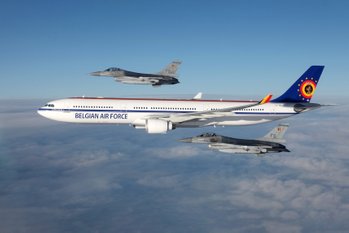
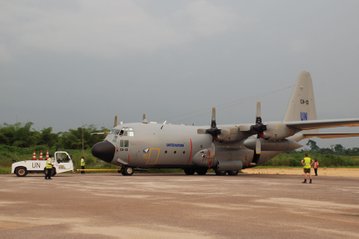
In large parts of Congo, the population is terrorised by state-run militias and organisations. The huge size of the country, with its poor infrastructure, ethnic differences and profit-seeking of local leaders further complicate the situation. Enforcing stability is a prerequisite for ensuring a safe living environment. The UN peacekeeping mission MONUC is being created to calm the unstable environment. Belgium will make a C-130H permanently available to the United Nations from 2009 to 2013.
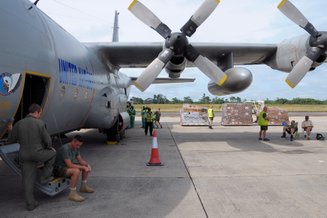
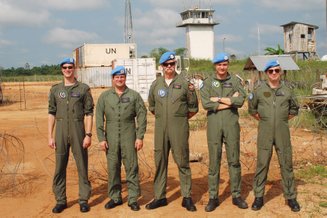
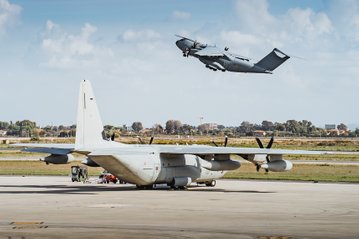
In September 2010, Belgium, the Netherlands, France and Germany jointly set up the EATC, the aim: to put the transport fleet of all participating countries under 1 command. This will lead to much more efficient use and deployment of transport capabilities within Europe. A capability of which there is at that time a great shortage both within the EU and NATO. More and more nations are joining (Spain, Italy and Luxembourg) and by 2023, the EATC's fleet will consist of no less than 150 aircraft, from passenger- and tactical transport to medical evacuation aircraft and tankers.
On Tuesday March 13, 2012, a coach carrying Belgian schoolchildren and their supervisors from schools in Lommel and Heverlee crashed into a concrete wall in a tunnel in Sierre, Switzerland. As a result, 22 children, 2 drivers and 4 teachers lost their lives. Hercules planes are deployed to repatriate the 28 victims to Belgium. These flights leave a deep impression on the crews and staff of the 15th Wing to this day.
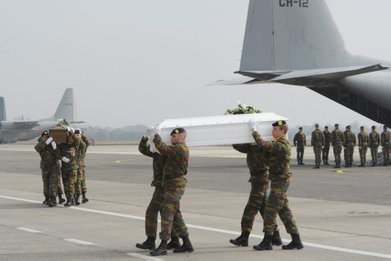
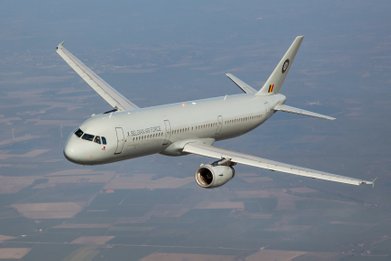
In 2014, the A330's lease ends and there is a need for a replacement. Operations in Afghanistan are coming to an end, reducing the need to transport large detachments over longer distances. As a result, Defence is opting for the smaller Airbus A321, although an additional fuel tank will be installed to increase the flying range. The aircraft will remain in service until the end of 2020.
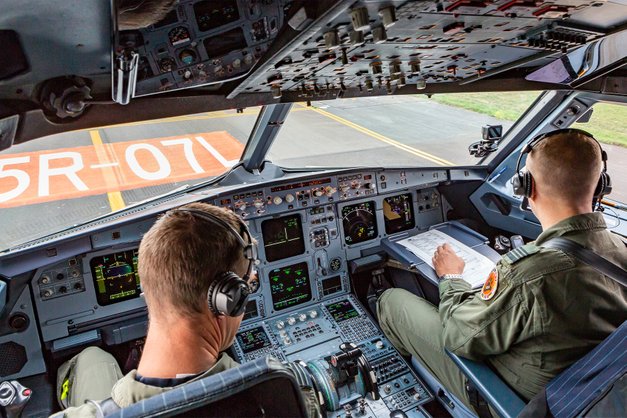
Mali is being torn apart by bloody rebellions. Rebels receive support from terrorist groups in the process. The United Nations is establishing the peacekeeping mission MINUSMA to safeguard stability in the Sahel region. The Belgian Air Force will support this mission by sending a Belgian Tactical Air Detachment (BELTAD) in May 2018. For fourteen months, our C-130H, together with the 1st Wing's NH90 and A109, will conduct liaison flights on behalf of the UN peacekeeping forces.
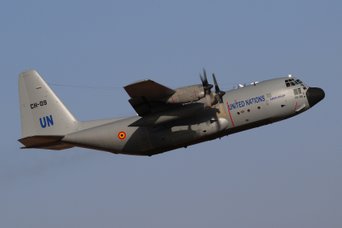
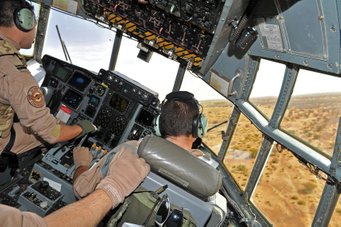
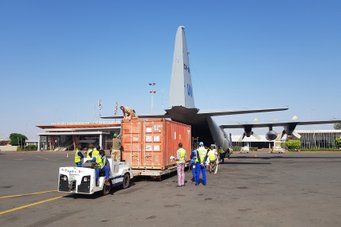
In 2020, it will be decided to replace the entire fleet of passenger aircraft with two leased Long-Range Jets of the Dassault Falcon 7X type. The aircraft can accommodate 16 passengers and have a flight range of as much as 11,000km. However, the Airbus A321 was not replaced.
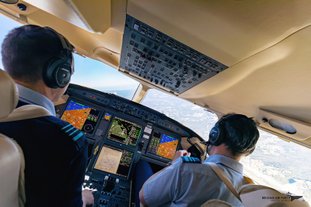
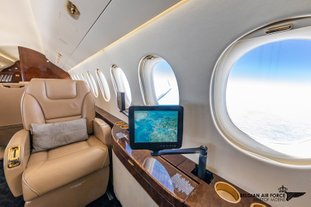
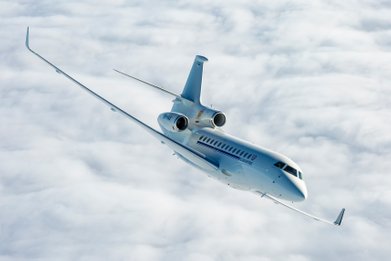
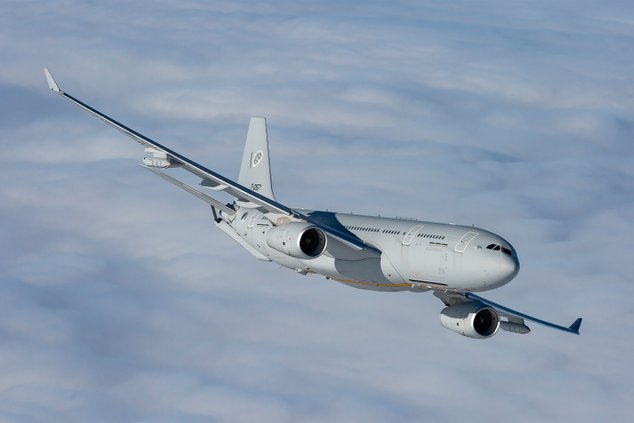
With Belgium's participation in the Multinational MRTT Unit (MMU) in Eindhoven, passenger transport will henceforth be provided by this unit. The Belgian government is investing the equivalent of 1 (and in 2023 a second) Airbus A330 Multi-Role Tanker Transport and we are providing crews and support personnel to this multinational unit. The aircraft is a real jack-of-all-trades. To carry out air-to-air refuelling missions, it is equipped with two systems, the advanced refuelling boom system in the rear on the one hand and hose and probe refuelling via the pod under both wings on the other. Both systems allow it to refuel all NATO fighters in flight.
Besides its main task of air refuelling, it can also carry 267 passengers and 45 tonnes of cargo. In addition, one of the nine aircraft will be converted to a medical evacuation configuration. This aircraft will be equipped with six intensive care units, 16 stretchers and 21 seats for medical support personnel.
On 9 October 2020, the first of eight brand new Airbus A400M Atlas transport aircraft will taxi onto the Melsbroek tarmac. These state-of-the-art aircraft were ordered 17 years earlier together with the Grand Duchy of Luxembourg from the Spanish aircraft manufacturer (7 BEL + 1 LUX). From then on, the 20th Squadron can officially be called a binational unit employing both Belgian and Luxembourg pilots, loadmasters and support staff. Switching from the C-130H to the A400M in terms of maintenance, management and deployment, and this in a very short period of time, is not a given and requires a lot of commitment and flexibility from the entire wing.
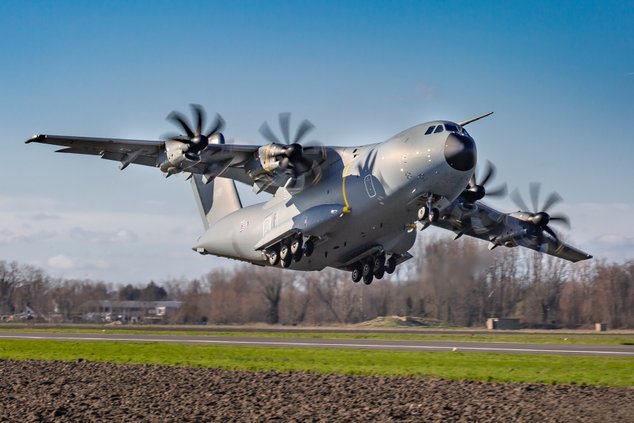
After the withdrawal of US troops from Afghanistan in May 2021, the Afghan army soon gives in to the Taliban. On August 15, the Taliban takes control of the capital Kabul and the first reports of a possible extraction of countrymen emerge. Just 48 hours later, a Falcon 7X takes off in Melsbroek carrying an Operational Liaison & Reconnaissance Team with destination Islamabad (Pakistan), to establish an airlift to Kabul from there. Two C-130Hs with ammunition and a technical detachment followed a day later, and an A400M with the intervention force followed later that day. The then brand-new Atlas immediately shows its worth by covering the 6,000km in one go with a full load.
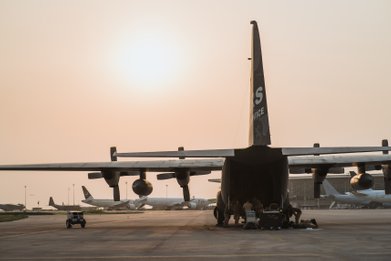
A headquarters is set up in the Belgian embassy while the technical detachment settles on the tarmac of the airport where they keep the aircraft operational all day without any protection from the scorching desert sun.
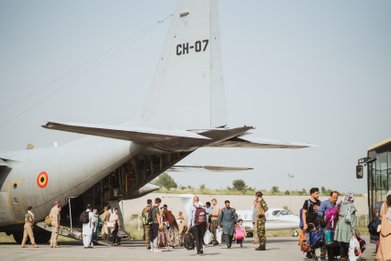
On August 20, the first C-130Hs leave for Kabul. People from the Special Operations Regiment and the Foreign Affairs were earlier brought to the scene by a Danish aircraft to prepare for the evacuation.
While the Hercules aircraft fly the people from Kabul to Islamabad, A330MRTT and charter aircraft are used to bring the evacuated people to Europe. On August 25, our C-130Hs will fly a 22nd and final time to the Afghan capital to pick up people, the situation is escalating rapidly and safety can no longer be guaranteed. Our aircraft will initially remain on standby before finally returning home on September 3. A total of 1,349 people are rescued from the Taliban regime.
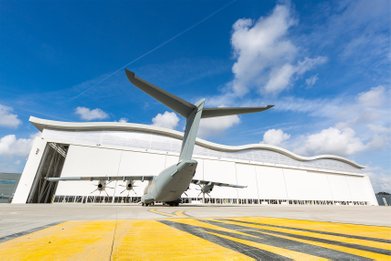
The official inauguration of a brand new maintenance complex for the A400M fleet in November 2021 will mark the start of the total renovation of the infrastructure. Most of the buildings date back to the 1940s and 1950s and are no longer suitable to house state-of-the-art and demanding aircraft. It will be a plan in several phases and spread over several years.
This hangar is the result of an international collaboration between Belgium and Luxembourg. With an area of 13 621 m², three A400M aircraft can be serviced simultaneously. Office space (1200 m²) and a logistics area (3500 m²) are also included. Various storage and workshop areas complete the new building. The roof construction with a span of 185 by 75 metres is unique in Belgium and allows unlimited freedom of movement. The building was completed in a record time of 20 months.
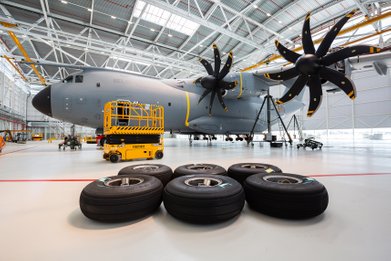
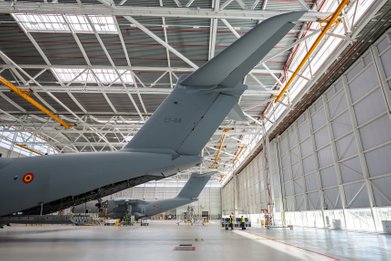
On December 22, 2021, the story of the mighty Hercules came to an end after more than 285,000 flying hours. For just under half a century, its silhouette was a familiar sight, not only in Belgium but far beyond. It brought support to troops in the field, relief to people in need and the, often very urgent, humanitarian goods to people on the African continent. A story that will continue to be written by the A400M Atlas from now on.
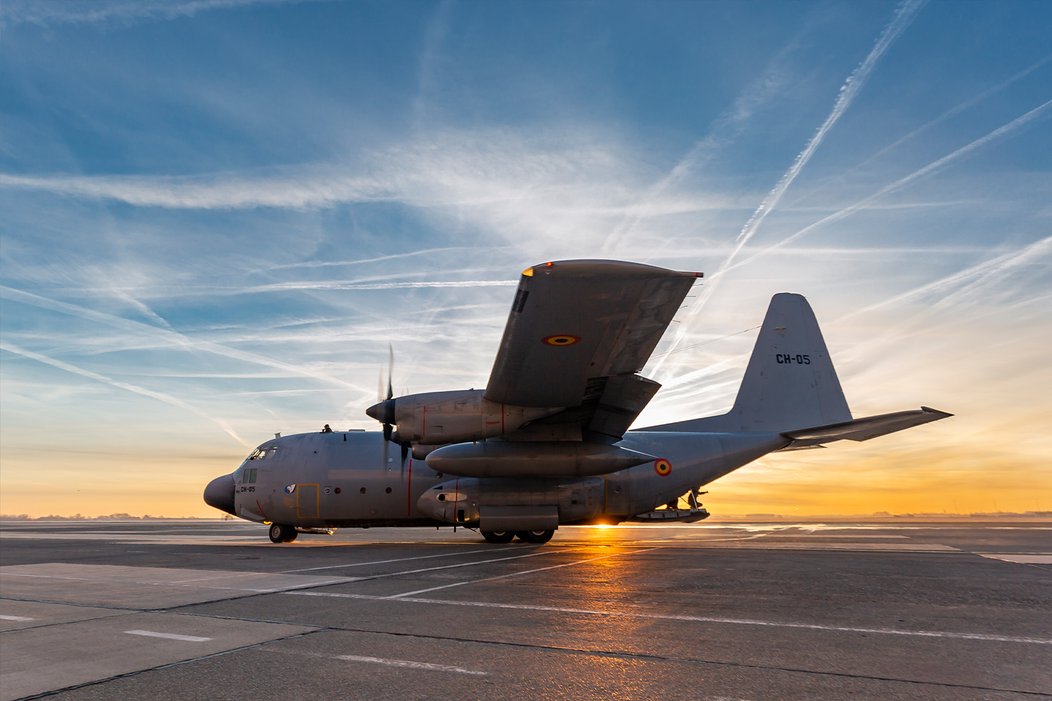
The heart of the training centre is the latest-generation Full Flight Simulator. This high-tech flight simulator is invaluable for pilot training and requalification on the A400M. The flight simulator is technologically of such a level that flight hours in the FFS are equivalent to those in a real A400M. Some 90% of the basic training of the A400M, including emergency training, is done on this simulator from now on. It provides a realistic three-dimensional environment in which very targeted training can be carried out. In this way, several situations can be practised in a few hours, such as different weather conditions or breakdowns. It is also possible to practice on situations that are difficult or impossible to practice in real life, such as failed parachutages or automatic landing failures in poor visibility. Besides pilots, loadmasters can also train in the BNTC. Using an interactive virtual tool, loadmasters learn to work with the loadmaster systems for payload management, drop sequences and emergency situations. Aircraft technicians also benefit from the simulator to practise maintenance tasks, such as engine start-up procedures.
